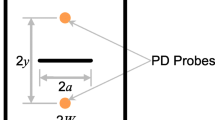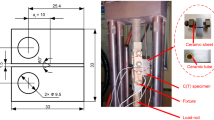Abstract
Finite element analysis procedures are utilized to provide theoretical calibration curves for the electrical potential crack-monitoring system as applied to single-edge-notch (SEN) and compact tension (CT) fracture specimens. The results are compared to existing calibrations for such test piece geometries derived using experimental, electrical analog and analytical (conformal mapping) procedures.
Résumé
Des procédures d'analyse par éléments finis sont utilisées pour fournir la courbe de calibrage théorique dans le cas d'un système d'avertissement de fissuration par potentiel électrique tel que appliqué dans les éprouvettes à entaille simple latérale et dans les éprouvettes de traction compactes utilisées pour l'étude de la rupture. Les résultats sont comparés avec les calibrages existants pour des géométries d'éprouvettes d'essai de ce type, qui dérivent de procédures expérimentales analogiques électriques et analytiques par représentation conforme.
Similar content being viewed by others
References
R.O. Ritchie, G.G. Garrett and J.F. Knott, International Journal of Fracture Mechanics, 7 (1971) RCR 462.
A. Trost, Metallwirtsch., 23 (1944) 308.
G. Gille, Maschinenschaden, 29 (1956) 123.
R.O. Ritchie and J.F. Knott, Acta Metallurgica, 21 (1973) 639.
W.J. Barnett and A.R. Troiano, Journal of Metals, 9 (1957) 486.
P. McIntyre, Proceedings British Steel Conference on Mechanics and Mechanisms of Crack Growth, Cambridge ed. M.J. May (April 1973) 121.
J.R. Haigh, R.P. Skelton and C.E. Richards, Materials Science and Engineering, 26 (1976) 167.
J.M. Lowes and G.D. Fearnehough, Engineering Fracture Mechanics, 3 (1971) 103.
J.D. Landes and J.A. Begley, Westinghouse Scientific Laboratories, Paper 76-IE7-JINTF-P3, (May 1976).
A.J. Carlsson, Transactions Royal Institute, Stockholm, Sweden, No. 189 (1962).
K.D. Unangst, T.T. Shih and R.P. Wei, Engineering Fracture Mechanics, 9 (1977) 725.
R.O. Ritchie and V.A. Chang, unpublished research, Rockwell International Science Center (July 1977).
H.H. Johnson, Materials Research and Standards, 5 (1965) 442.
Che-Yu Li and R.P. Wei, Materials Research and Standards, 6 (1966) 392.
G. Clark and J.F. Knott, Journal of the Mechanics and Physics of Solids, 23 (1975) 265.
A.A. Anctil, E.B. Kula and E. DiCesare, Proceedings of American Society Testing Materials, 63 (1963) 799.
D.M. Gilbey and S. Pearson, Royal Aircraft Establishment Technical Report No. 66402, Farnborough, England (Dec. 1966).
O.E. Zienkiewicz, in The Finite Element Method in Engineering Science, McGraw-Hill Book Co. (1971).
K.J. Bathe and E.L. Wilson, in Numerical Methods in Finite Element Analysis, Prentice-Hall (1976).
K.J. Bathe, “ADINAT—A Finite Element Program for Automatic Dynamic Incremental Nonlinear Analysis of Temperatures”, Acoustics and Vibration Laboratory Report 82448-5, MIT (1977).
G.G. Garrett, Ph.D. Thesis, University of Cambridge (July 1973).
P. McIntyre and A.H. Priest, BISRA Open Report No. MG/54/71, British Steel Corporation, London (1971).
R.O. Ritchie, Department of Metallurgy, University of Cambridge, Internal Report (Jan. 1972).
Author information
Authors and Affiliations
Rights and permissions
About this article
Cite this article
Ritchie, R.O., Bathe, K.J. On the calibration of the electrical potential technique for monitoring crack growth using finite element methods. Int J Fract 15, 47–55 (1979). https://doi.org/10.1007/BF00115908
Received:
Revised:
Issue Date:
DOI: https://doi.org/10.1007/BF00115908



